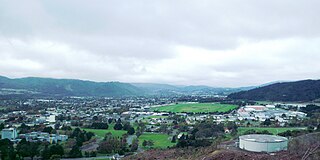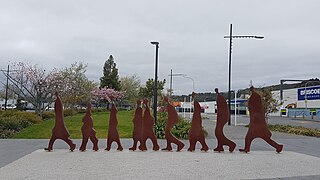
Eastbourne is a suburb of Lower Hutt, a part of Wellington, New Zealand. Lying beside the sea, it is a popular local tourist destination via car from Petone or from ferry crossings from central Wellington. An outer suburb, it lies on the eastern shore of Wellington Harbour, five kilometres south of the main Lower Hutt urban area and directly across the harbour from the Miramar Peninsula in Wellington city. A narrow exposed coastal road connects it with the rest of Lower Hutt via the Eastern Bays and the industrial suburb of Seaview. It is named for Eastbourne in England, another seaside town known as a destination for day-trips.

Trentham is the most populous suburb of Upper Hutt, a city in the Wellington region of New Zealand. The suburb is located in a widening of the Hutt Valley, five kilometres to the southwest of the Upper Hutt city centre.

Silverstream is a suburb of Upper Hutt in New Zealand, just under 7 km south-west of the Upper Hutt CBD. It is in the lower (southern) part of the North Island of New Zealand at the southern end of Upper Hutt, close to the Taitā Gorge, which separates Upper Hutt from Lower Hutt. The area is sited at the mouth of a small valley formed by the Wellington Region's tectonic activity and, in part, by Hull's Creek, which discharges into the Hutt River.

Pinehaven is a suburb of Upper Hutt City in the lower North Island of New Zealand, established in 1927. It is at the southern end of the city, within the pine covered hills east of Silverstream.

Sanson is a small settlement in the Manawatu District of New Zealand. It is located just south of Bulls and the Rangitikei River, and west of the city of Palmerston North.
Te Mārua is the easternmost urban suburb of Upper Hutt. For reasons of location and distance from the city, the area is often classified as rural. Te Mārua is well known for its Plateau Reserve where remnants of the old Rimutaka Railway path can be found, which now form part of a historic walk. Mt Climie, the highest peak of the Remutaka Range, can also be reached from the reserve. The suburb is also the location of the Wellington Speedway, a nationally important venue for stock car racing, and of the Wellington Naturist Club's club grounds, venue of the historic 2016 World Congress of the International Naturist Federation.
Alicetown is a central suburb of Lower Hutt located at the bottom of the North Island of New Zealand.

Belmont, a suburb of Lower Hutt, to the north of Wellington in the North Island of New Zealand, lies on the west bank of the Hutt River, on State Highway 2, the Wellington-Hutt main road, and across the river from the centre of Lower Hutt.
Waterloo is an eastern suburb of Lower Hutt, Wellington. It is named after the Battle of Waterloo won by the Duke of Wellington in 1815.

Moera, a suburb of the city of Lower Hutt in New Zealand, forms part of the urban area of greater Wellington.
Elderslea is a suburb of Upper Hutt located in the lower North Island of New Zealand, near Upper Hutt Central.

Upper Hutt Central is the commercial and geographic focal point of Upper Hutt city, located in the lower North Island of New Zealand.
Clouston Park is a suburb of Upper Hutt, located 0.5 – 2.5 km east-northeast from the city centre. It was predominantly developed in the 1970s and 1980s. While the suburb is predominantly flat, there are a few larger homes situated on the lower slopes of the Eastern Hutt Valley Hills that offer wide views of the Upper Hutt Valley.
Maoribank is a suburb of Upper Hutt, located 2–3 km east-northeast of the city centre. It was predominantly developed between 1950-1970 and had a population of just less than 1000 at the 2013 Census.
Hutt Central, a suburb of the city of Lower Hutt in New Zealand, forms part of the urban area of greater Wellington. It includes the Lower Hutt CBD.
Tirohanga is a suburb of Lower Hutt City situated at the bottom of the North Island of New Zealand. The suburb is located on the western side of the Hutt River and State Highway 2.

Waiwhetū is an eastern suburb of Lower Hutt in the Wellington Region situated in the south of the North Island of New Zealand.
Maungaraki is a suburb of Lower Hutt City situated at the bottom of the North Island of New Zealand. The suburb is located on the western hills of the Hutt Valley with access to the area via State Highway 2 and offers extensive views of Wellington harbour and Matiu/Somes Island. It contains the largest suburban development on the Hutt Valley's western escarpment that runs along the Wellington Fault.
Gracefield is an industrial suburb of Lower Hutt City, located at the bottom of the North Island of New Zealand.

Korokoro, a suburb of Lower Hutt City, lies in the south of the North Island of New Zealand. The suburb occupies part of the western hills of the Hutt Valley; its eastern slopes overlook Petone and the Wellington harbour.










